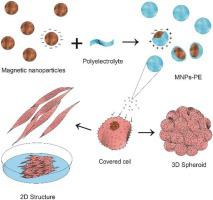Journal of Biotechnology ( IF 4.1 ) Pub Date : 2020-12-04 , DOI: 10.1016/j.jbiotec.2020.12.003 Elvira Rozhina 1 , Anna Danilushkina 1 , Farida Akhatova 1 , Ramil Fakhrullin 1 , Artem Rozhin 1 , Svetlana Batasheva 1

|
Fe3O4 nanoparticles were obtained by chemical coprecipitation of iron chloride and sodium hydroxide. The morphology and sizes of the obtained nanoparticles were characterized using laser Doppler velocimetry, transmission electron and atomic force microscopy. Then the nanoparticles were stabilized by three polycations (polyethylenimine (PEI), poly(allylamine hydrochloride) (PAH), poly(diallyldimethylammonium chloride) (PDADMAC)) to increase their biocompatibility. The cytotoxicity of the obtained polymer-stabilized nanoparticles was studied using a human lung carcinoma cell line (A549). The biodistribution of nanoparticles stabilized by polycations in human lung carcinoma cells was analyzed by transmission electron microscopy, and the toxicity of nanomaterials was evaluated using toxicity tests and flow cytometry. As a result, the most biocompatible nanoparticle-biopolymer complex was identified. PAH stabilized magnetic nanoparticles demonstrated the best biocompatibility, and the PEI-magnetic nanoparticle complex was the most toxic.
中文翻译:

使用 A549 细胞包覆聚阳离子的磁性纳米粒子的生物相容性
Fe 3 O 4通过氯化铁和氢氧化钠的化学共沉淀获得纳米颗粒。使用激光多普勒测速仪、透射电子和原子力显微镜对所得纳米颗粒的形态和尺寸进行表征。然后通过三种聚阳离子(聚乙烯亚胺(PEI)、聚(烯丙胺盐酸盐)(PAH)、聚(二烯丙基二甲基氯化铵)(PDADMAC))稳定纳米颗粒,以增加它们的生物相容性。使用人肺癌细胞系 (A549) 研究了获得的聚合物稳定纳米颗粒的细胞毒性。通过透射电子显微镜分析了聚阳离子稳定的纳米粒子在人肺癌细胞中的生物分布,并使用毒性试验和流式细胞术评估了纳米材料的毒性。其结果,确定了最具生物相容性的纳米颗粒-生物聚合物复合物。PAH 稳定的磁性纳米粒子表现出最好的生物相容性,PEI-磁性纳米粒子复合物的毒性最大。



























 京公网安备 11010802027423号
京公网安备 11010802027423号